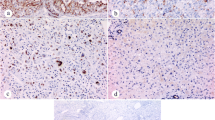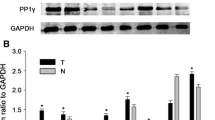Abstract
Background
Hepatocellular carcinoma (HCC) has a high recurrence rate after resection. Abnormal activation of the sonic hedgehog (SHH) signaling pathway contributing to the carcinogenesis of some organs had been reported. We hypothesize that activation of SHH pathway contributes to the recurrence of HCC after surgical resection.
Methods
In a prospective study, from January 2006 to June 2010, a total of 50 consecutive patients with HCC after curative resection were enrolled. The ratio of the expression of messenger RNA (mRNA) of SHH, patched homolog-1 (PTCH-1) and glioma-associated oncogene-1 (GLI-1) between HCC tissues and the paired noncancerous liver tissues were measured. Both the clinicopathologic characteristics and these ratios were compared between those with recurrence and those without recurrence. They were also compared between those with and without survival.
Results
There was a statistically significant correlation among the ratios of PTCH-1 mRNA and serum AFP level (p = 0.045), tumor size (p = 0.001), vascular permeation (p = 0.043) and tumor, node, metastasis staging system (TNM) stage (p = 0.003). A borderline significant correlation was found among ratios of GLI-1 mRNA and tumor size (p = 0.062) and TNM stage (p = 0.051). There was no such significant correlation between SHH mRNA and any parameter. Both the ratios of PTCH-1 mRNA and GLI-1 mRNA significantly adversely affected recurrence (p = 0.003 and 0.005, respectively) and survival (p < 0.001 and <0.001, respectively).
Conclusions
Expression of PTCH-1 mRNA and GLI-1 mRNA in HCC tissues is a potential biomarker to predict postresection disease recurrence.

Similar content being viewed by others
References
Venook AP, Papandreou C, Furuse J, de Guevara LL. The incidence and epidemiology of hepatocellular carcinoma: a global and regional perspective. Oncologist. 2010;15:5–13.
Parkin DM, Bray F, Ferlay J, et al. Estimating the world cancer burden: Globocan 2000. Int J Cancer. 2001;94:153–6.
Island ER, Pomposelli J, Pomfret EA, Gordon FD, Lewis WD, Jenkins RL. Twenty-year experience with liver transplantation for hepatocellular carcinoma. Arch Surg. 2005;140:353–8.
Poon RT, Fan ST, Wong J. Risk factors, prevention, and management of post-operative recurrence after resection of hepatocellular carcinoma. Ann Surg. 2000;232:10–24.
Jeng KS, Chen BF, Lin HJ. En bloc resection for extensive hepatocellular carcinoma: is it advisable? World J Surg.1994;18:834–9.
Chen MF, Hwang TL, Jeng LB, Wang CS, Jan YY, Chen SC. Postoperative recurrence of hepatocellular carcinoma. Two hundred five consecutive patients who underwent hepatic resection in 15 years. Arch Surg. 1994;129:738–42.
Kondo K, Chijiiwa K, Makino I, et al. Risk factors for early death after liver resection in patients with solitary hepatocellular carcinoma. J Hepatobiliary Pancreat Surg. 2005;12:399–404.
Agathocleous M, Locker M, Harris WA, Perron M. A general role of hedgehog in the regulation of proliferation. Cell Cycle. 2007;6:156–9.
Ingham PW. Transducing hedgehog: the story so far. EMBO J.1998;17:3505–11.
Harmon EB, Ko AH, Kim SK. Hedgehog signaling in gastrointestinal development and disease. Curr Mol Med. 2002;2:67–82.
Chari NS, McDonnell TJ. The sonic hedgehog signaling network in development and neoplasia. Adv Anat Pathol. 2007;14:344–52.
Taipale J, Beachy PA. The hedgehog and wnt signaling pathways in cancer. Nature. 2001;411:349–54.
Warkins DN, Peacock CD. Hedgehog signaling in foregut malignancy. Biochem Pharmacol. 2004;68:1055–60.
Thayer SP, diMagliano MP, Heiser PW, et al. Hedgehog is an early and late mediator of pancreatic cancer tumorigenesis. Nature. 2003;425:851–6.
Ma X, Chen K, Huang S, et al. Frequent activation of the hedgehog pathway in advanced gastric adenocarcinomas. Carcinogenesis. 2005;26:1698–705.
Karhadkar SS, Bova GS, Abdallah N, et al. Hedgehog signaling in prostate regeneration, neoplasia and metastasis. Nature. 2004;431:707–12.
Ma X, Sheng T, Zhang Y, et al. Hedgehog signaling is activated in subsets of esophageal cancers. Int J Cancer. 2006;118:139–48.
Bale AE, Yu KP. The hedgehog pathway and basal cell carcinomas. Hum Mol Genet. 2001;10:757–62.
Che L, Ren J, Yuan YH, et al. Expression of genes related to sonic hedgehog signaling in human hepatocellular carcinomas. Beijing Da Xue Xue Bao. 2008;40:616–23.
Sicklick JK, Li YX, Jayaraman A, et al. Dysregulation of the hedgehog pathway in human hepatocarcinogenesis. Carcinogenesis. 2006;27:748–57.
Huang S, He J, Zhang X, et al. Activation of the hedgehog pathway in human hepatocellular carcinomas. Carcinogenesis. 2006;27:1334–40.
Cheng WT, Xu K, Tian DY, Zhang ZG, Liu LJ, Chen Y. Role of hedgehog signaling pathway in proliferation and invasiveness of hepatocellular carcinoma cells. Int J Oncol. 2009;34:829–36.
Fu X, Wang Q, Chen X, et al. Expression patterns and polymorphisms of PTCH in Chinese hepatocellular carcinoma patients. Exp Mol Pathol. 2008;84:195–9.
Choi SS, Omenetti A, Witek RP, et al. Hedgehog pathway activation and epithelial-to-mesenchymal transitions during myofibroblastic transformation of rat hepatic cells in culture and cirrhosis. Am J Physiol Gastrointest Liver Physiol. 2009;297:G1093–106.
Athar M, Li C, Tang X, Chi S, et al. Inhibition of smoothened signaling prevents ultraviolet B-induced basal cell carcinomas through regulation of Fas expression and apoptosis. Cancer Res. 2004;64:7545–52.
Adolphe C, Hetherington R, Ellis T, Wainwright B. Patched1 functions as a gatekeeper by promoting cell cycle progression. Cancer Res. 2006;66:2081–8.
Barnes EA, Kong M, Ollendorff V, Donoghue DJ. Patched1 interacts with cyclin B1 to regulate cell cycle progression. EMBO J. 2001;20:2214–23.
You S, Zhou J, Chen S, et al. PTCH1, a receptor of hedgehog signaling pathway, is correlated with metastatic potential of colorectal cancer. Ups J Med Sci. 2010;115:169–75.
Wang Q, Huang S, Yang L, et al. Down-regulation of sonic hedgehog signaling pathway activity is involved in 5-fluorouracil-induced apoptosis and motility inhibition in Hep3B cells. Acta Biochim Biophys Sin (Shanghai). 2008;40:819–29.
Mori Y, Okumura T, Tsunoda S, et al. GLI-1 expression is associated with lymph node metastasis and tumor progression in esophageal squamous cell carcinoma. Oncology. 2006;70:378–89.
ten Haaf A, Bektas N, von Serenyi S, et al. Expression of the glioma-associated oncogene homolog (GLI) 1 in human breast cancer is associated with unfavorable overall survival. BMC Cancer. 2009;25;9:298.
Jeng KS, Sheen IS, Tsai YC. Does the presence of circulating hepatocellular carcinoma cells indicate a risk of recurrence after resection? Am J Gastroenterol. 2004;99:1503–9.
Berman DM, Karhadkar SS, Hallahan AR, et al. Medulloblastoma growth inhibition by hedgehog pathway blockade. Science. 2002;297:1559–61.
Chen XL, Cheng QY, She MR, et al. Expression of sonic hedgehog signaling components in hepatocellular carcinoma and cyclopamine-induced apoptosis through Bcl-2 downregulation in vitro. Arch Med Res. 2010;41:315–23.
Acknowledgment
Supported in part by Far Eastern Memorial Hospital and by financial support from a research grant of National Science Council. Executive Yuan, Taiwan, ROC (NSC-97-2314-B-418-008-MY3, Taiwan).
Author information
Authors and Affiliations
Corresponding authors
Rights and permissions
About this article
Cite this article
Jeng, KS., Sheen, IS., Jeng, WJ. et al. High Expression of Patched Homolog-1 Messenger RNA and Glioma-Associated Oncogene-1 Messenger RNA of Sonic Hedgehog Signaling Pathway Indicates a Risk of Postresection Recurrence of Hepatocellular Carcinoma. Ann Surg Oncol 20, 464–473 (2013). https://doi.org/10.1245/s10434-012-2593-y
Received:
Published:
Issue Date:
DOI: https://doi.org/10.1245/s10434-012-2593-y




